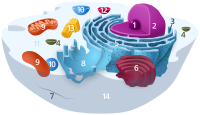
Photo from wikipedia
Cell polarization plays a crucial role in dynamic cellular events, such as cell proliferation, differentiation, and directional migration in response to diverse extracellular and intracellular signals. Although it is well… Click to show full abstract
Cell polarization plays a crucial role in dynamic cellular events, such as cell proliferation, differentiation, and directional migration in response to diverse extracellular and intracellular signals. Although it is well known that cell polarization entails highly orchestrated intracellular molecular reorganization, the underlying mechanism of repositioning by intracellular organelles in the presence of multiple stimuli is still unclear. Here, we show that front-rear cell polarization based on the relative positions of nucleus and microtubule organizing center is precisely controlled by mechanical interactions including cellular adhesion to extracellular matrix and nucleus-cytoskeletal connections. By modulating the size and distribution of fibronectin-coated adhesive spots located in the polarized cell shape mimicking micropatterns, we monitored the alterations in cell polarity. We found that the localization of individual adhesive spots is more dominant than the cell shape itself to induce intracellular polarization. Further, the degree of cell polarization was diminished significantly by disrupting nuclear lamin A/C. We further confirm that geometrical cue-guided intracellular polarization determines directional cell migration via local activation of Cdc42. These findings provide novel insights into the role of nucleus-cytoskeletal connections in single cell polarization under a combination of physical, molecular, and genetic cues, where lamin A/C acts as a critical molecular mediator in ECM sensing and signal transduction via nucleus-cytoskeletal connection.
Journal Title: Biomaterials
Year Published: 2020
Link to full text (if available)
Share on Social Media: Sign Up to like & get
recommendations!